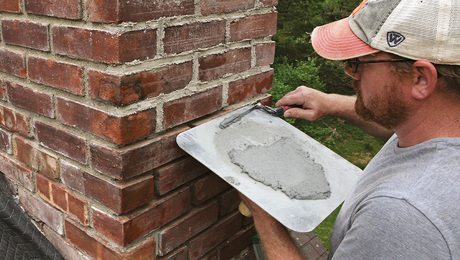How much slope should a rain gutter have?
Discussion Forum
Discussion Forum
Up Next
Video Shorts
Featured Story

Old masonry may look tough, but the wrong mortar can destroy it—here's how to choose the right mix for lasting repairs.
Featured Video
How to Install Exterior Window TrimHighlights
"I have learned so much thanks to the searchable articles on the FHB website. I can confidently say that I expect to be a life-long subscriber." - M.K.
Fine Homebuilding Magazine
- Home Group
- Antique Trader
- Arts & Crafts Homes
- Bank Note Reporter
- Cabin Life
- Cuisine at Home
- Fine Gardening
- Fine Woodworking
- Green Building Advisor
- Garden Gate
- Horticulture
- Keep Craft Alive
- Log Home Living
- Military Trader/Vehicles
- Numismatic News
- Numismaster
- Old Cars Weekly
- Old House Journal
- Period Homes
- Popular Woodworking
- Script
- ShopNotes
- Sports Collectors Digest
- Threads
- Timber Home Living
- Traditional Building
- Woodsmith
- World Coin News
- Writer's Digest


















Replies
as long as the end being lower than the start. I know plumbing is 1/4 per foot. and since rain is just water, 1/16 to 1/8 per foot. depends on how much water coming off roof.
I would base it on a few different factors. I have it dead level because it looks better, I'm in Southern California and I don't have much debris filling it up.
To slope it 2" in 10' feet in both directions makes most eaves look unplumbed. If the down spout is only at one end it will look worst. If over flowing gutters can cause damage, then slope it as much as possible. If the area is large vs small, that will be the determination factor.
As much as possible. Longer runs tend to have shallower pitches, of course. One option on a long run is to break it in the middle and pitch to both ends. Use an expansion joint on really long runs to avoid oil-canning.
Andy
"Never try to teach a pig to sing. It wastes your time and annoys the pig." Robert A. Heinlein
"Get off your dead #### and on your dying feet." Mom
Use an expansion joint on really long runs to avoid oil-canning.
I have had really bad experience with expansion joints in long runs of gutters (60-70'). They have eventually leaked no matter what sealant was used during installation or repair efforts.
I now break the long runs in half, using end caps, cover the butt joint with a piece of flashing, and the face with a small section cut from the gutter. Looks just like an expansion joint when I'm done, but allows the the two sections to expand and contract a lot more. Best of all, no leaks and no call backs.
Dave
Dave, that's exactly the kind of expansion joint I'd have recommended. You're right as rain.Andy
"Never try to teach a pig to sing. It wastes your time and annoys the pig." Robert A. Heinlein
"Get off your dead #### and on your dying feet." Mom
correct my thinking here...
why is any pitch in a gutter necessary?
If you had a lenght of gutter, with down spouts on either end, therefore, a hole at either end, and so long as the gutter was not invertered towards the center, it would drain itself with out any problem.... as the water falls through the down-spout it will level itself off and continue to fall and create it's own flow.
Pitch is not strictly neccessary. Water will roll out once enough collects. However, it drains faster with pitch, and that can be important in heavy rains. Of course, the ultimate limiting factor in drainage rate is downspout size. Use the largest ones you can find.
The other problem with level gutters is that really, are they level? Or do the back-pitch in places? If so, ponding results, bringing with it mosquitos.
I wrote an article on gutters in FHB some years back. You can probably buy it over on the main site if you're so inclined. Andy
"Never try to teach a pig to sing. It wastes your time and annoys the pig." Robert A. Heinlein
"Get off your dead #### and on your dying feet." Mom
LIke Andy said.
Pitching also allows shingle granules, dirt and leaves to flow out a little easier.
as the water falls through the down-spout it will level itself off and continue to fall and create it's own flow.
'Cause Murphy hates us, one and all. Therefore, if you don't put some pitch in, Murph will insure that the "flat" pitch is wrong, and in the most damaging, least visible way, possible.
Does not mean you can't just use, say, width of the chalk line, for the pitch. Just that a person "ought to." Even in a place as dry as Tucumcari, where it doesn't rain that often--but when it does, it does it all day.Occupational hazard of my occupation not being around (sorry Bubba)
I was just curious as to why not.
I understand wanting to create some additional flow to carry away roofing granules etc.
was just curious as to why not.
<G> 'Cause the "no pitch" gutters always seem to have a low spot furthest from the downleaders, and a kink trying to pull them off the fascia, making a gap filled up with gunk, which then gets inbehid everything else, and that's why the soffit leaks when it rains <g> . . .
Occupational hazard of my occupation not being around (sorry Bubba)
I need to get pics posted of how NOT to do it, we demo'd 300' of galv half round today, and rehung 200' of it.
Lack of cleaning, clogged undergrounds, and pisspoor first install lead to this job.
I think in the last 3 weeks, we schlepped up about 1k feet of gutter, one in particular was miter city, and another, landscape from hell..Grant just informed me the next one is 800' of gutter!Mostly from our lift...yikes.
I really like doing the gutter jobs, but the circle hangers for half round leave a lot to be desired.
What Andy said, bigger downspouts are a great way to help with the flow, as is a mitered downspout vs. an elbow.
Spheramid Enterprises Architectural Woodworks
There is no cure for stupid. R. White.
"as the water falls through the down-spout it will level itself off and continue to fall and create it's own flow.
'Cause Murphy hates us, one and all. Therefore, if you don't put some pitch in, Murph will insure that the "flat" pitch is wrong, and in the most damaging, least visible way, possible."
This is exactly what is happening with mine. It's around an octagonal sceen porch and the section in the middle is level and collects water. It drains fine most of the time, but in a downpour it overflows.
We go for 1/8'' per foot, but a long run and you can run out of fascia ( gutter hangs below) or you show too much up at the drip edge.
So, in that case, go sloped, then level, then sloped, then level and ALWAYS keep corners level at the miters, much easier to have look right and go together well.
Spheramid Enterprises Architectural Woodworks
There is no cure for stupid. R. White.
Confusing grammer: "How much fall in rain gutters"
How [many] fall in[to] rain gutters?
How much autumn [is] in rain gutters?
Most houses are gable roofed since most production framers don't know how to do hipped roofs. Thus most houses have two sides with eaves and two sides with gables. Seven gables sounds fishy. Anyway, most people put their gutters under the eaves and, since the eaves are not sloped, the gutters don't drain well. So they slope the gutters and this throws off the picture perfect, McMansion look.
Obviously, the solution is to think outside the cardboard - or is it medium density fiberboard - box and come to this brilliant conclusion: "If I place my gutters under the gables, which have plenty of slope, then the gutters will automatically have plenty of slope." The house will still have two sides protected by gutters so what's the difference? Isn't it time we give tribute to Betty Gable and her gams and stop paying so much attention to Eave Arden?
Furthermore, everyone makes the mistake of hanging the gutters on the oytside of the roof line. This is a mistake. This exposes the gutter to all the leaves and other debris that washes off the roof. People will also lean extinction ladder against them thus denting them. My simple remedy is to hang the gutter underneath the eave. This will eliminate these problems and furthermore eliminate the need for pure copper downspouts. [Sorry CU.] I live in San Diego and have had no problem whatever thus far.
~Peter
Two days left for Seattle and Tacoma.
Confusing word choice: "People will also lean extinction ladder against them thus denting them."
Then ya hadda go be a Peter who pecked and hailed the water with some pale comparisons:
Eave Gardens...and glammed Gables...
<g>
be...one who doth twist the tongue firmly in checkered creek...
DUM SPIRO SPERO: "While I breathe I hope"
the ladder he has in mind will extinct ya in a heartbeat...
be careful out there...
or is that oyut there...Life is not a journey to the grave with the intention of arriving safely in a pretty and well preserved body, but rather to skid in broadside, thoroughly used up, totally worn out, and loudly proclaiming<!----><!----><!---->
WOW!!! What a Ride!<!----><!---->
Forget the primal scream, just ROAR!!!
"People will also lean extinction ladder against them thus denting them."
You've obviously not seen some of the people operating extension ladders that I have <g>. How that 'tribe' has avoided extinction still amazes me . . .
(It's those "little" things, like being socheap as to buy a 16' when you really need a 22" . . . )Occupational hazard of my occupation not being around (sorry Bubba)
Truly an inspired reply!
I think anyone not a member of this forum is missing a lot of high-quality advice.
Forrest
> Most houses are gable roofed since most production framers don't know how to do hipped roofs.
It depends on the climate. In heavy snow country, like Scandinavia, you don't see a lot of hip roofs. The doors go on the gable ends, because that's where the snow doesn't fall off. With a hip roof, they'd be in trouble all the way around.
-- J.S.
Guess they'd have to stay in and do, you know, that.
Forrest
Most houses are gable roofed since most production framers don't know how to do hipped roofs
Wow, you're just cruisin' to see if Blue'll come start a flame war, right . . . ? <half grin>
That, and around here, the "less fancy" builders all build hip roofs (they'd rather eyeball hips & jacks than solve the riddle of return v. mutton chop).
So "cheap is as cheap does" varies by region.
And regions differ. My local design rainfall is just shy of 3" (max 24hr is 17.5") or about 5# the linear foot of gutter at 3" deep--so hanging gutters not off the face of fascia sounds a bit "iffy" to me.
Ok, so, in SD, 3" of rain is likely going to make the news, here in my river valley, the question is what to do with the rain after you get it down the downleader . . . Occupational hazard of my occupation not being around (sorry Bubba)
These folks say an inch in 40 ft is the minimum:
http://www.guttersupply.com/content.php?page=faq
-- J.S.